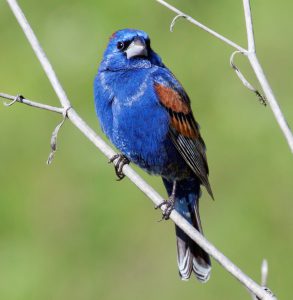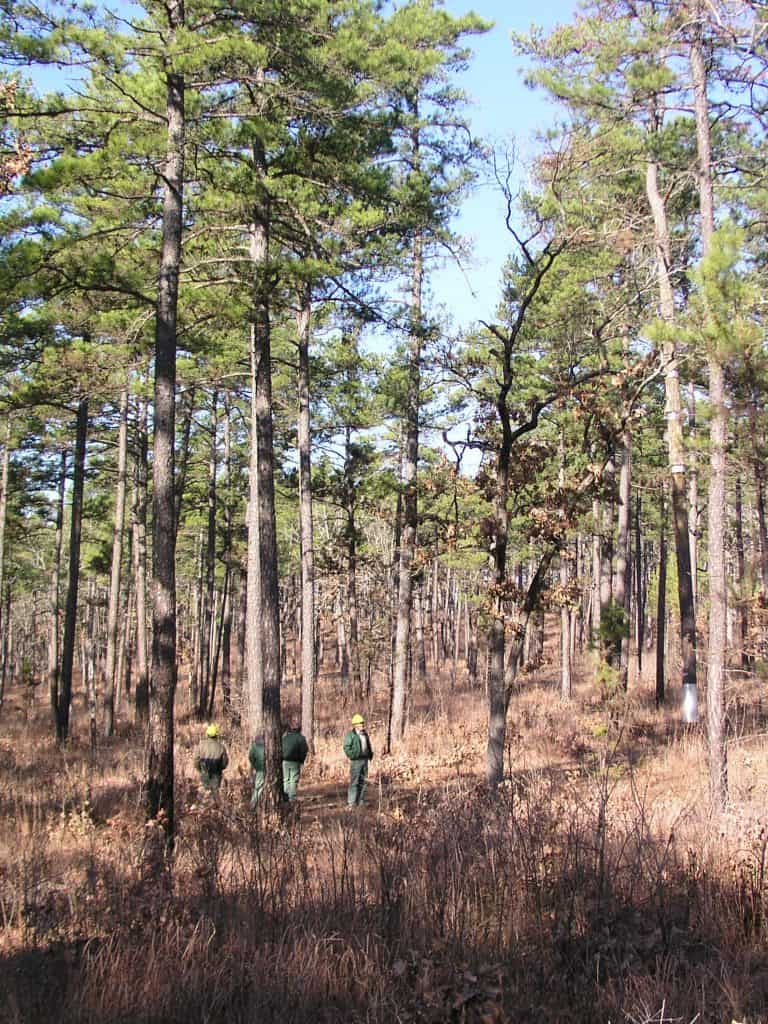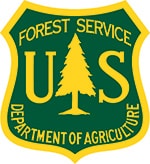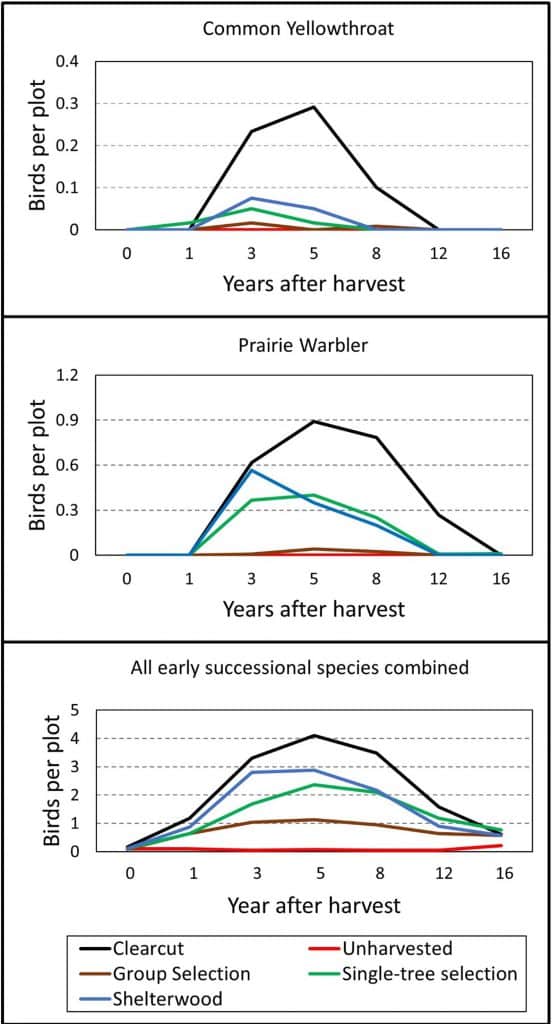Share this article
Early successional forest ecosystems: What we’ve learned about birds and timber harvest practices
I had been walking with a graduate student through second-growth, mature pine forests in the Ouachita Mountains of western Arkansas since sunrise. We were conducting a spring bird survey, stopping and counting birds at marked points along the trail. The dense tree canopy obstructed much of our view, so we identified the birds by their songs and calls. Our routine was to stop for 10 minutes and record the species − an ovenbird (Seiurus aurocapilla) off in the distance, a few pine warblers (Setophaga pinus) and an occasional tufted titmouse (Baeolophus bicolor). We followed the trail into a young, open clearcut and made our way through the thicket of brush, thorns and tangled vines typically found in these young forest stands. When we got to our final point and began tallying birds, the student, who had no previous survey experience, remarked that he was overwhelmed with the numerous calls and songs from birds all around him. I told him it takes a lot of practice to monitor so many birds at once, so I concentrate on one species at a time, counting how many I hear and noting the direction of each call.
Our survey that day was part of a large-scale, long-term research project initiated in 1992 to evaluate the ecological effects of four different timber harvest methods. Our goal with this study was to determine how different timber harvest methods affected early successional birds over a 17-year period. The study included two intensive methods that remove most of the trees, namely clearcutting, which removes most or all of the mature trees, and shelterwood harvest, which leaves 20 to 40 of the largest trees per acre. The study also included two less-intensive harvest methods that leave more trees. Group selection removes small groups of trees in openings less than two acres, and single-tree selection limits removal to individual tress scattered throughout the forest.
Early successional forest ecosystems
Young clearcuts are an example of early successional forests that occur during the first few years after a disturbance. . The importance of disturbances in Eastern forests that create environments necessary for the survival and reproduction of early successional plants, insects, and wildlife — whether from timber harvest, fire, or wind — has been the focus of substantial research (Greenberg et al. 2011). Today, many ecologists recognize the importance of early successional forests for numerous wildlife species across the eastern U.S.
But in the last 65 years or so, the expanse of early successional conditions, including early successional forests, has declined throughout the East due to fire suppression, farm abandonment, land development, reduction in timber harvest and recolonization by second-growth forests (Brooks 2003). Consequently, population numbers for many wildlife species associated with these ecosystems have declined throughout portions of the eastern U.S. (Litvaitis 2001, Thompson and DeGraaf 2001).
Annual breeding bird surveys show the impacts. Prairie warblers have declined 2 percent annually and Kentucky warblers have declined 1 percent annually since 1968 in forests of the eastern U.S. (State of the Birds 2014). Because of these declines, ecologists have become more focused on techniques used by forest managers — fire, timber harvest, and other disturbances — for maintaining early successional forests.
Study history
In the early 1990s, the Ouachita National Forest (ONF) faced criticism over its timber management activities in second-growth pine and pine-hardwood forests of Arkansas and Oklahoma. Citizen groups and organizations filed appeals and began a campaign focused on stopping the use of clearcutting on the ONF (Curran 1994). In response to this public concern, the U.S. Forest Service launched an initiative that included enhanced public interaction combined with research on different types of timber harvests. The goal was to find an ecologically feasible and more socially acceptable replacement for clearcutting (Curran 1994) that was based on scientific studies of how different timber harvest methods affect various aspects of forest ecology, from soil erosion and tree regeneration to visual appeal and wildlife.
The USFS Southern Research Station spearheaded this large-scale, long-term research project in cooperation with the ONF and the Ozark-St. Francis National Forest. Dozens of scientists from the research station and universities across the South participated (Baker 1994). Along with others studies started about the same time, these initiatives ushered in the era of “ecosystem management” on public lands, whereby the use of plantation forestry was largely replaced by an ecological approach to managing forests. Wildlife studies associated with the ONF initiative examined timber harvest impacts on small mammals, herpetofauna, and wildlife habitat, as well as early successional forest birds (Perry and Thill 2013).
Bird by bird
As the dominant forestry practice for decades, clearcutting has been the subject of many studies examining the response of early successional forest birds to the technique. In general, clearcuts provide early successional conditions for numerous shrubland birds for the first three to 15 years after harvest (Dickson et al. 1993). Over time, however, the forest canopy closes and shrubland species are replaced with mature-forest species.

The blue grosbeak is another example of an early successional species that occurs in harvested stands between the first and eighth years after harvest.
Our study used trained birders to count all birds heard or seen during 10-minute counts at five 40-meter-radius plots within each stand. All stands in the study were approximately 40 acres, which is about the typical size for public forest stand-level management in the region. We examined 12 species of birds associated with forest disturbance. Nine of these species — American goldfinch (Carduelis tristis), blue grosbeak (Passerina caerulea), common yellowthroat (Geothlypis trichas), indigo bunting (Passerina cyanea), prairie warbler (Setophaga discolor), northern bobwhite (Colinus virginianus), yellow-breasted chat (Icteria virens), field sparrow (Spizella pusilla), and white-eyed vireo (Vireo griseus) — were early successional forest species often associated with young clearcuts. Three additional species — including northern cardinal (Cardinalis cardinalis), Kentucky warbler (Oporornis formosus), and hooded warbler (Setophaga citrina) — were associated with less intense disturbances that generally retain some mature trees.
Most species showed a similar response to the four harvest methods. The birds were absent in mature forests before harvest, increased in numbers over time after harvest, peaked, and then declined as the trees in the stand grew together and the canopies closed. Most species showed peak numbers around five years after harvest, but hooded warblers and Kentucky warblers peaked around eight to 12 years after harvest. Although the patterns of counted birds were similar among the different harvest methods, the number of birds counted for each species often differed among harvest methods, with clearcuts often having the greatest numbers. In unharvested stands, early successional species remained rare or absent throughout the study. For northern bobwhite, clearcuts produced significantly higher numbers of birds than other harvest methods or unharvested stands.
In light of the public’s aversion for clearcutting on public lands, shelterwood harvests offer the closest approximation to clearcuts, given the numbers of early successional species found in that harvest treatment. In addition, shelterwood and single-tree selection stands provide habitat to bird species that require both mature trees and abundant shrubs, such as Kentucky and hooded warblers, which were rare in both unharvested stands and clearcuts. These findings suggest that single-tree selection or shelterwood methods not only provide habitat for early successional birds, but also provide habitat for many bird species that require mature trees. Studies in other areas, including oak-dominated forests, have produced similar results (Kendrick et al. 2015).
Studies in other areas have looked at effects of size and shape of forest openings on early successional forest birds. Canopy openings created in group-selection stands provided habitat for many species, but these openings were generally not large enough for species that require larger blocks of shrubby habitat such as yellow-breasted chat and prairie warbler (Rodewald and Vitz 2005). Similar to bird species that breed in mature-forest interiors and avoid edges, early successional species may avoid edges of mature forests and small or irregular patches, dominated by edge, are unlikely to provide suitable habitat for many shrubland birds (Schlossberg and King 2008).
Forest management tools

Today, Ouachita National Forest managers routinely conduct field tours for various organizations and the public to explain management efforts such as this woodland restoration.
In the absence of further disturbances such as prescribed burning, early successional forests are ephemeral and typically provide suitable habitat for a short period, often less than 10 years. Today, we know these forests often provided some of the most species-rich habitats across a landscape, and taxa including small mammals, birds, and their predators may reach their greatest abundance and diversity in these ecosystems (Greenberg et al. 2011).
But studies show that public perception of landscape management activities is often based on visual appeal. Nevertheless, such perceptions may interfere with important habitat management decisions. Clearcutting receives the greatest negative response (Gobster 2001) for obvious reasons. Based on their unsightly, brushy condition, early successional forests have been labeled “unpopular habitats” by researchers, based on public perception (Askins 2001).
Over time, forest management methods evolve based on results of research and the experience of managers. Introducing fire back into landscapes is becoming a popular tool among forest managers and restoring historic woodland conditions is increasingly becoming a management priority. However, research on how these harvest methods interact with prescribed fire and bird populations is still needed. The responses of wildlife we found in the ONF study illustrate the relevancy of research to examine other aspects of forest management including patch size, arrangement of stands differing in successional stage, harvest methods, and fire.
The ONF’s ecosystem management initiative resulted in dramatic changes in how the forest is managed. Forest managers initiated large-scale woodland and old-growth restoration efforts, including extensive ecological research into management actions. Continuous and substantive involvement by the public in the decision-making process is now a routine practice. They also use public outreach, including demonstration field tours to various interested groups, to inform the public on land management activities that demonstrate what is being done and why. In addition, clearcutting was curtailed, except in special circumstances such as reforesting newly acquired lands, and shelterwood and seed-tree harvests are now the primary forest regeneration methods.
 The success of the ONF’s initiative became a model for conducting ecosystem management and was recognized nationally by President Clinton in the 1990s for leadership in resolving large-scale ecological and societal challenges (Curran 1994). Today its management practices represent an example of the value of scientifically based forest- and wildlife-management practices that include aggressive public interaction.
The success of the ONF’s initiative became a model for conducting ecosystem management and was recognized nationally by President Clinton in the 1990s for leadership in resolving large-scale ecological and societal challenges (Curran 1994). Today its management practices represent an example of the value of scientifically based forest- and wildlife-management practices that include aggressive public interaction.
 Roger W. Perry, PhD, is a research wildlife biologist with the U.S. Forest Service, Southern Research Station.
Roger W. Perry, PhD, is a research wildlife biologist with the U.S. Forest Service, Southern Research Station.
Header Image: The common yellowthroat, an early successional bird species, is often found in recent timber harvests.










